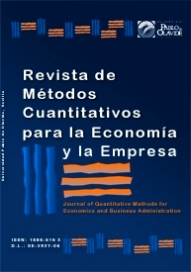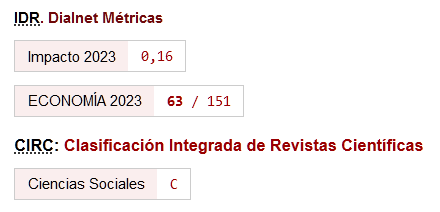El papel de las tecnologías de la información y la comunicación (TIC) en la relación entre asimetría de la información y desarrollo financiero: nuevas pruebas basadas en el modelo PSTR
DOI:
https://doi.org/10.46661/rev.metodoscuant.econ.empresa.6999Palabras clave:
Tecnología de información y comunicación, desarrollo financiero, asimetría en la información, oficinas de información compartida, regresión de transición suave de panelResumen
Las tecnologías de la información y la comunicación (TIC) tienen potencial para complementar a las oficinas de intercambio de información (OIC) en la reducción de la asimetría de la información (AI) para mejorar el desarrollo financiero. Utilizando las TIC como variable de transición, esta investigación emplea el modelo de regresión de transición suave de panel (PSTR) para examinar la influencia de la AI en el desarrollo financiero de 33 países menos adelantados (PMA) durante el periodo 2000-2021. Los resultados indican que el AI y el desarrollo financiero tienen un nexo no lineal. Cuando la TIC está por debajo del valor umbral, la PCR tiene un impacto negativo en el desarrollo financiero. En cambio, cuando las TIC superan el umbral, es decir, en el régimen alto, el coeficiente es positivo. Esto significa que el efecto negativo de la PCR sobre el desarrollo financiero se compensa e incluso se convierte en positivo a medida que aumentan las TIC. La PCB tiene un efecto positivo en el desarrollo financiero tanto en el régimen de TIC bajo como en el alto. Con el traspaso del umbral de TIC, crece el impacto favorable de la PCB en la reducción del AI en la dirección del desarrollo financiero. La implicación oculta es que PCR y PCB (con IA decreciente) promueven el desarrollo financiero, cuando las TIC están en un nivel alto. En otras palabras, las TIC podrían complementar las características de la RCP y el PCB para reducir el AI y aumentar el desarrollo financiero.
Descargas
Citas
Aboody, D., & Lev, B. (2000). Information asymmetry, R&D, and insider gains. The journal of Finance, 55(6), 2747-2766.
https://doi.org/10.1111/0022-1082.00305
Akerlof, G. A. (1970). Quality uncertainty and the. The quarterly journal of economics, 84(3), 488-500.
https://doi.org/10.2307/1879431
Akerlof, G., Spence, M., & Stiglitz, J. (2001). Information asymmetry at the heart of the new microeconomics.. Problemes economiques, 19-24.
Allen, F., Otchere, I., & Senbet, L. W. (2011), African financial systems: a review, Review of Development Finance, 1(2), pp. 79-113.
https://doi.org/10.1016/j.rdf.2011.03.003
Asongu, S. (2015). The impact of mobile phone penetration on African inequality. International Journal of Social Economics, 42(8), 706-716.
https://doi.org/10.1108/IJSE-11-2012-0228
Asongu, S. A., & Moulin, B. (2016). The role of ICT in reducing information asymmetry for financial access. Research in International Business and Finance, 38, 202-213.
https://doi.org/10.1016/j.ribaf.2016.04.011
Asongu, S. A., Nwachukwu, J. C., & Tchamyou, V. S. (2016). Information asymmetry and financial development dynamics in Africa. Review of Development Finance, 6(2), 126-138.
https://doi.org/10.1016/j.rdf.2016.09.001
Asongu, S., & Nnanna, J. (2018). ICT in reducing information asymmetry for financial sector competition. DBN Journal of Economics and Sustainable Growth (Forthcoming), AGDI Working Paper No. WP/18/035.
https://doi.org/10.2139/ssrn.3265094
Asongu, S., Le Roux, S., Nwachukwu, J., & Pyke, C. (2019). Reducing Information Asymmetry with ICT: A critical review of loan price and quantity effects in Africa. International Journal of Managerial Finance. Vol. 15 No. 2, 130-163. https://doi.org/10.1108/IJMF-01-2018-0027
Bacon, D. W., & Watts, D. G. (1971). Estimating the Transition between Two Intersecting Straight Lines. Biometrika, 58(3), 525-534. https://doi.org/10.2307/2334387
Baltagi, B. H., Bratberg, E., & Holmås, T. H. (2005). A panel data study of physicians' labor supply: the case of Norway. Health Economics, 14(10), 1035-1045.
https://doi.org/10.1002/hec.991
Baltagi, B. H., and Q. Li (1995). Testing AR (1) against MA (1) disturbances in an error component model. Journal of Econometrics, Volume 68, Issue 1, 133-151.
https://doi.org/10.1016/0304-4076(94)01646-H
Batuo, E., & Kupukile, M. (2010). How can economic and political liberalisation improve financial development in African countries? Journal of Financial Economic Policy, 2(May), 35-59. 10.1108/17576381080001419
https://doi.org/10.1108/17576381080001419
Bayram, Ö. G., & Demirtel, H. (2014). Effect of ICT on information sharing in enterprises: The case of Ministry of Development. Volume One, 94.
Colletaz, G. and Hurlin, C. (2006). Threshold Effects of the Public Capital Productivity: An
International Panel Smooth Transition Approach. Working Paper, 1/2006, LEO, Université d'Orléans.
Diamond, D. W. (1984). Financial intermediation and delegated monitoring. The review of economic studies, 51(3), 393-414.
https://doi.org/10.2307/2297430
Diamond, D. W., & Dybvig, P. H. (1983). Bank runs, deposit insurance, and liquidity. Journal of political economy, 91(3), 401-419.
https://doi.org/10.1086/261155
Do, Q. T., & Levchenko, A. A. (2004). Trade and financial development. Available at SSRN 610391.
https://doi.org/10.1596/1813-9450-3347
Domowitz, I. (2002). Liquidity, transaction costs, and reintermediation in electronic markets. Journal of Financial Services Research, 22(1-2), 141-157.
https://doi.org/10.1023/A:1016077023185
Eitrheim, Ø., & Teräsvirta, T. (1996). Testing the adequacy of smooth transition autoregressive models. Journal of Econometrics, 74(1), 59-75.
https://doi.org/10.1016/0304-4076(95)01751-8
Fok, D., van Dijk, D. & Franses, P. (2005). A Multi-Level Panel STAR Model for US Manufacturing Sectors, Journal of Applied Econometrics, 20(6), 811-827
https://doi.org/10.1002/jae.822
Fouquau, J., Hurlin, C., & Rabaud, I. (2008). The Feldstein-Horioka puzzle: A panel smooth transition regression approach. Economic Modelling, 25(2), 284-299.
https://doi.org/10.1016/j.econmod.2007.06.008
Galindo, A., & Miller, M. (2001). Can credit registries reduce credit constraints? Empirical evidence on the role of credit registries in firm investment decisions. In Annual Meetings of the Inter-American Development Bank, Santiago Chile.
Geng, N. (2011). The dynamics of market structure and firm-level adjustment to India's pro-market economic liberalizing reforms, 1988-2006: A Time Varying Panel Smooth Transition Regression (TV-PSTR) approach. International Review of Economics & Finance, 20(4), 506-519.
https://doi.org/10.1016/j.iref.2010.09.007
Gonzalez, A. Terasvirta, T. & van Dijk, D. , & Yang, Y. (2017). Panel smooth transition regression model. SSE/EFI Working Paper Series in Economics and Finance 604, Stockholm School of Economics.
Greenwood, J., & Jovanovic, B. (1990). Financial development, growth, and the distribution of income. Journal of Political Economy, 98(5 Part 1), 1076-1107.
https://doi.org/10.1086/261720
Gries, T., Kraft, M., & Meierrieks, D. (2009). Linkages between financial deepening, trade openness, and economic development: Causality evidence from Sub-Saharan Africa. World Development, 37(12), 1849-1860.
https://doi.org/10.1016/j.worlddev.2009.05.008
Hansen, B. E. (1999). Threshold effects in non-dynamic panels: Estimation, testing, and inference. Journal of econometrics, 93(2), 345-368.
https://doi.org/10.1016/S0304-4076(99)00025-1
Huang, Y., & Temple, J. R. (2005). Does external trade promote financial development?. Bristol Economics Discussion Papers 05/575, School of Economics, University of Bristol, UK.
Ibrahim, M., & Alagidede, P. (2017). Financial Development, Growth Volatility and Information Asymmetry in Sub‐Saharan Africa: Does Law Matter? South African Journal of Economics, 85(4), 570-588.
https://doi.org/10.1111/saje.12176
International Telecommunication Union (ITU). Measuring the Information Society Report. (2017). Volume 1,
Jappelli, T., & Pagano, M. (2002). Information sharing, lending and defaults: Cross-country evidence. Journal of Banking & Finance, 26(10), 2017-2045.
https://doi.org/10.1016/S0378-4266(01)00185-6
Jiang, L., & Kim, J. B. (2004). Foreign equity ownership and information asymmetry: Evidence from Japan. Journal of International Financial Management & Accounting, 15(3), 185-211.
https://doi.org/10.1111/j.1467-646X.2004.00107.x
Jude, E. C. (2010). Financial development and growth: A panel smooth regression approach. Journal of Economic Development, 35(1), 15.
https://doi.org/10.35866/caujed.2010.35.1.002
Kim, D. H., Lin, S. C., & Suen, Y. B. (2010). Dynamic effects of trade openness on financial development. Economic Modelling, 27(1), 254-261.
https://doi.org/10.1016/j.econmod.2009.09.005
Leitão, N. C. (2012). Bank credit and economic growth: A dynamic panel data analysis. Economic Research Guardian, 256-267.
Levine, R. (1997). Financial development and economic growth: views and agenda. Journal of Economic Literature, 35(2), 688-726.
Levine, R. (2005). Finance and growth: theory and evidence. Handbook of economic growth, 1, 865-934.
https://doi.org/10.1016/S1574-0684(05)01012-9
Love, I., & Mylenko, N. (2003). Credit reporting and financing constraints (No. 3142). World Bank Publications.
https://doi.org/10.1596/1813-9450-3142
Luukkonen, R., Saikkonen, P., & Teräsvirta, T. (1988). Testing linearity in univariate time series models. Scandinavian Journal of Statistics, Vol. 15, No. 3, pp. 161-175
Mylenko, N. (2008). Developing credit reporting in Africa: opportunities and challenges. In African Finance for the 21st Century, High Level Seminar Organized by the IMF Institute in collaboration with the Joint Africa Institute, Tunis, Tunisia.
Nan, S., Huang, J., Wu, J., & Li, C. (2022a). Does globalization change the renewable energy consumption and CO2 emissions nexus for OECD countries? New evidence based on the nonlinear PSTR model. Energy Strategy Reviews, 44, 100995.
https://doi.org/10.1016/j.esr.2022.100995
Nan, S., Wang, Z., Wang, J., & Wu, J. (2022b). Investigating the Role of Green Innovation in Economic Growth and Carbon Emissions Nexus for China: New Evidence Based on the PSTR Model. Sustainability, 14(24), 16369.
https://doi.org/10.3390/su142416369
Pénard, T., Poussing, N., Zomo Yebe, G., & Ella, N. (2012). Comparing the determinants of internet and cell phone use in Africa: evidence from Gabon. Communications & Strategies, (86), 65-83.
Pesaran, M. H. (2003). Estimation and inference in large heterogenous panels with cross section dependence. Available at SSRN 385123.
https://doi.org/10.2139/ssrn.385123
Pesaran, M. H. (2015). Testing weak cross-sectional dependence in large panels. Econometric reviews, 34(6-10), 1089-1117.
https://doi.org/10.1080/07474938.2014.956623
Purcell, F., & Toland, J. (2003). E‐Finance for Development: Global Trends, National Experience and SMEs. The Electronic Journal of Information Systems in Developing Countries, 11(1), 1-4.
https://doi.org/10.1002/j.1681-4835.2003.tb00069.x
Rezagholizadeh, M., & Abdi, Y. (2022). Financial development and development of renewable energy technologies: A comparison of developing and developed countries. ECONOMICS AND POLICY OF ENERGY AND THE ENVIRONMENT, FrancoAngeli Editore, vol. (1), pages 95-118.
https://doi.org/10.3280/EFE2022-001006
Saint-Paul, G. (1992). Fiscal policy in an endogenous growth model. The Quarterly Journal of Economics, 107(4), 1243-1259.
https://doi.org/10.2307/2118387
Tchamyou, V. S., & Asongu, S. A. (2017). Information sharing and financial sector development in Africa. Journal of African Business, 18(1), 24-49.
https://doi.org/10.1080/15228916.2016.1216233
Seleteng, M., Bittencourt, M., and Van Eyden, R. (2013). Non- Linearities in inflation- growth nexus in the SADC region: A panel smooth transition regression approach. Economic Modelling, 30, 149-156.
https://doi.org/10.1016/j.econmod.2012.09.028
Teräsvirta, T. (1996). Modelling economic relationships with smooth transition regressions (No. 131). Stockholm School of Economics.
Thuy, D. P., Nguyen Trong, H. (2021). Impacts of openness on financial development in developing countries: Using a Bayesian model averaging approach. Cogent Economics & Finance, 9(1), 1937848.
https://doi.org/10.1080/23322039.2021.1937848
Triki, T., & Gajigo, O. (2014). Credit bureaus and registries and access to finance: new evidence from 42 African countries. Journal of African Development, 16(2), 73-101.
https://doi.org/10.5325/jafrideve.16.2.0073
United Nations. Least Developed Countries (LDCs). (2022).
Descargas
Publicado
Cómo citar
Número
Sección
Licencia
Derechos de autor 2024 Mahdieh Rezagholizadeh, Majid Aghaei, Atefeh Alipour Kebria

Esta obra está bajo una licencia internacional Creative Commons Atribución-CompartirIgual 4.0.
El envío de un manuscrito a la Revista supone que el trabajo no ha sido publicado anteriormente (excepto en la forma de un abstract o como parte de una tesis), que no está bajo consideración para su publicación en ninguna otra revista o editorial y que, en caso de aceptación, los autores están conforme con la transferencia automática del copyright a la Revista para su publicación y difusión. Los autores retendrán los derechos de autor para usar y compartir su artículo con un uso personal, institucional o con fines docentes; igualmente retiene los derechos de patente, de marca registrada (en caso de que sean aplicables) o derechos morales de autor (incluyendo los datos de investigación).
Los artículos publicados en la Revista están sujetos a la licencia Creative Commons CC-BY-SA de tipo Reconocimiento-CompartirIgual. Se permite el uso comercial de la obra, reconociendo su autoría, y de las posibles obras derivadas, la distribución de las cuales se debe hacer con una licencia igual a la que regula la obra original.
Hasta el volumen 21 se ha estado empleando la versión de licencia CC-BY-SA 3.0 ES y se ha comenzado a usar la versión CC-BY-SA 4.0 desde el volumen 22.










